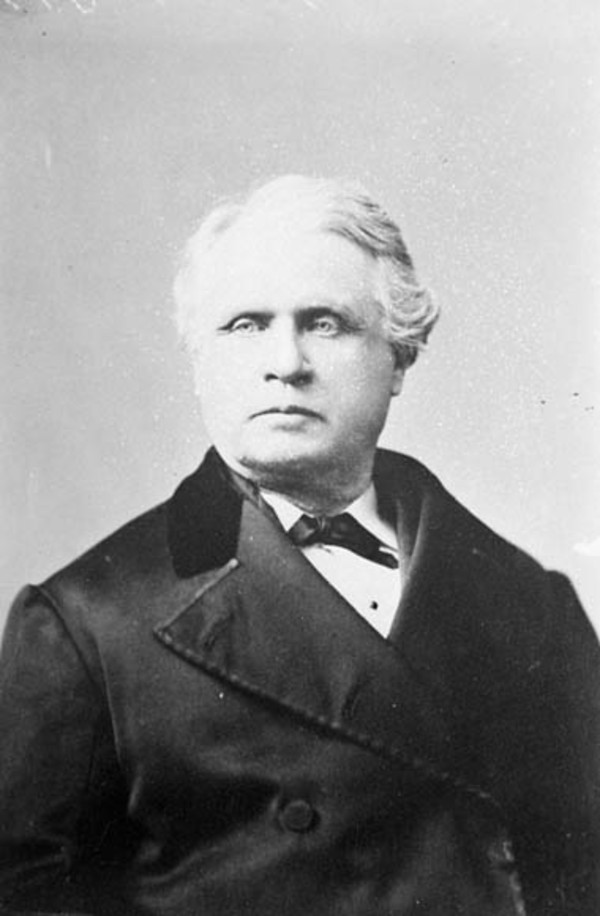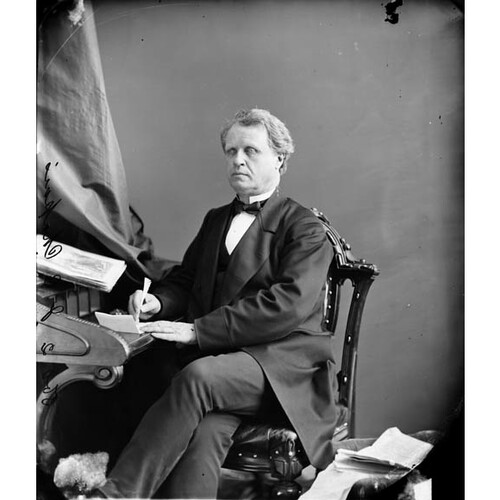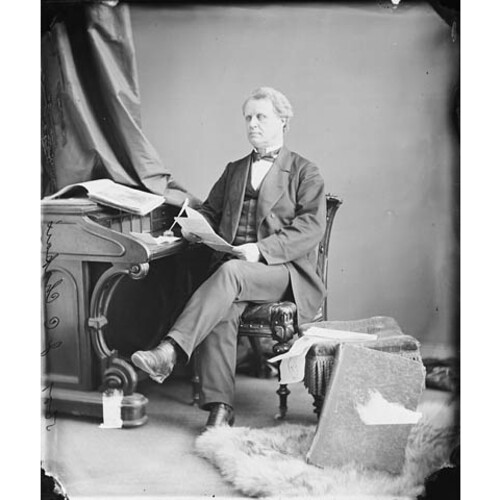As part of the funding agreement between the Dictionary of Canadian Biography and the Canadian Museum of History, we invite readers to take part in a short survey.
CHAPAIS, JEAN-CHARLES, businessman and politician; b. 2 Dec. 1811 at Rivière-Ouelle, Lower Canada, son of Jean-Charles Chapais, merchant, and Julienne Boucher; m. 30 June 1846 Georgina Dionne, whose uncle, Charles-Paschal-Télesphore Chiniquy*, performed the ceremony; they had six children, including Thomas*, a politician and historian, and Jean-Charles, an author of several books and pamphlets on agriculture; d. 17 July 1885 at Ottawa, Ont., and was buried 22 July in the church of Saint-Denis-de-la-Bouteillerie at Saint-Denis, Que.
Jean-Charles Chapais’s ancestors came from Normandy. François and Jean Chapais left Brécey for New France around 1740, after Intendant Gilles Hocquart* had decided a new levy of settlers was needed. Jean established himself on land in the seigneury of La Bouteillerie (or Rivière-Ouelle), first opened for settlement in 1672. The economic and social ascent of the Chapais family took several generations. Jean-Charles was born into a reasonably well-to-do family that took an interest in the political life of the country as well as in the social problems of the parish. He was given a superior education, the prerogative of young men of social standing at that time. After studying at Rivière-Ouelle with Rémi Béchard, an experienced teacher “selected and engaged” by the Chapais and Boucher families “for the training of their sons,” he received a classical education at the Séminaire de Nicolet from 1824 to 1830. He then spent two years in Quebec City where to satisfy his father’s ambitions he took private English lessons from the Reverend Daniel Wilkie* and endeavoured “to make the best possible contacts in Quebec society.”
In 1833 Jean-Charles Chapais bought two plots of land for his son in the fief of Saint-Denis, between the La Bouteillerie and Kamouraska seigneuries. There the young man became a “smallwares retail merchant,” as well as being a farmer and a wholesaler. His business concerns grew rapidly, in response to the needs of those in the surrounding countryside. During the 1840s Chapais was a member of the two firms of Chapais et fils and Chapais et frères. He also raised cattle and farmed, and in addition exploited the “Pêche à Belle,” a concession for a net fishery which he had leased in 1839. Through these various economic activities, as well as the substantial dowry of his wife Georgina Dionne, he was soon in comfortable circumstances and was even reputed to be extremely rich. These factors also made him the pivot of economic and social development in Saint-Denis. Chapais’s business interests attracted settlers and people of all trades to Saint-Denis and he provided a livelihood for a fair number of employees through his general store, farm, and fishery. He fought tenaciously for the canonical establishment and incorporation of the parish, and was involved in building a chapel in 1839 and a parish church between 1840 and 1856. Active in organizing education and in setting up a public library, he took part in the incorporation of the municipality, becoming its first mayor in 1845 and its first postmaster in 1849. Saint-Denis grew in a few decades from a sparsely populated village into a prosperous, well-organized centre as a result of Chapais’s efforts.
In the 19th century such an influential person was bound to have a political career, and in 1851 the second phase of Jean-Charles’s life began. His father-in-law, Amable Dionne*, a Kamouraska merchant, a member of the Legislative Council for Canada East, and one of the richest and most influential French Canadians of the time, dreamed of making his son-in-law a political leader in the district. When the Legislative Assembly seat for Kamouraska became vacant in 1850, Chapais, who confessed he had “never wanted to become a member of the legislature,” yielded to Dionne and to pressure from his friends, and stood for election. He thought he would be unopposed, but the Rouges ran Luc Letellier de Saint-Just, a notary in Rivière-Ouelle, against him. Letellier won. Chapais and Letellier were adversaries on five occasions between 1850 and 1857 and their electoral contests became legendary for their bitterness and violence, with the results often disputed and sometimes declared invalid. Chapais, who took the seat in 1851, represented Kamouraska until confederation. He supported Conservative leaders Augustin-Norbert Morin*, Étienne-Paschal Taché*, and George-Étienne Cartier*, although he also sympathized deeply with Louis-Victor Sicotte. In 1863 he refused to join the government of George Brown* and Antoine-Aimé Dorion*, because, as a friend commented, he would not agree “to tarnish 13 years of good political life in a single day.”
Chapais was rarely in the forefront in the house, but did have some influence on legislation which concerned Canada East relating to agriculture, settlement, education, and the abolition of the seigneurial system, as well as the laying out of the Intercolonial Railway and the development of the Grand Trunk, of which he was appointed a director by the government. In 1864 Chapais became commissioner of public works; it was as a member of the cabinet that he took part in the work that prepared the way for confederation. However, his active participation was limited to the Quebec conference, and for a while he was cool towards Hector-Louis Langevin*, who, though younger than he, was a delegate not only at Charlottetown but also in London.
Appointed in July 1867 to Sir John A. Macdonald*’s cabinet as minister of agriculture, Chapais sought the federal and the provincial seats for Kamouraska in the general elections held that year. However, as a result of electoral illegalities, the riding lost its right to both provincial and federal representation for two years. The provincial seat of Champlain, vacated in November 1867, provided Chapais with an alternative and he was returned by acclamation. Two months later he was appointed to the Senate for the division of La Durantaye. He remained minister of agriculture until 1869 when he became receiver general, a post he held until 1873. As an mla at Quebec and a senator and minister at Ottawa, Chapais was one of the politicians who monopolized power following confederation. When the double mandate was abolished in 1871 he withdrew from the provincial scene. Two years later he resigned from the federal government. Historians have usually linked Chapais’s resignation to the New Brunswick separate schools question, but it seems clear that a pretext has been interpreted as a decisive cause. Pressure was certainly brought to bear on Chapais to give up his ministerial post and this was, in his wife’s words, a source of “sorrow” and “disappointment” to him. In 1869 Macdonald had already transferred Chapais from the important ministry of agriculture to the post of receiver general, and thereby set him on the path which sooner or later would lead to his withdrawal from the government. In 1873 Macdonald’s party was in crisis and he endeavoured to improve the status of his ministry by bringing in new and stronger figures who were both competent and flexible. He also sought to strengthen his position in the House of Commons by introducing into the cabinet more representatives from the house itself. With this in mind, Macdonald insisted on the resignation of the man whom, in a pejorative but significant fashion, he called “my nun”; he chose Théodore Robitaille*, who was a member of the House of Commons, as Chapais’s successor.
In his Manuel électoral: portraits et dossiers parlementaires du premier parlement de Québec, Auguste Achintre notes that Chapais “is still, at the present date [1871], a minister whose modesty and unselfishness seem to limit his value and diminish his influence.” Admittedly, Chapais’s whole political career with the exception of the electoral contests in Kamouraska deserves this judgement, despite the fact that historians, influenced by the preoccupations of traditional historiography, have attached more importance to that part of his career than to his economic and social activity in Saint-Denis. The name of Jean-Charles Chapais is just a shadowy watermark in the political history of the 19th century but it is written with bold, indelible strokes in the institutions and history of Saint-Denis.
[The following newspapers were consulted regarding the important events in the career of Jean-Charles Chapais: Le Courrier de Saint-Hyacinthe, Le Courrier du Canada, Le Journal de Québec, La Minerve, Le Pionnier de Sherbrooke (Sherbrooke, Qué.), and L’Union des Cantons de l’Est (Arthabaska, Qué.). a.d.]
ANQ-Q, AP-G-36; AP-G-134; AP-G-242. PAC, MG 26, A. Can., Sénat, Débats, 1868–85. Can., prov. du, Assemblée législative, Journaux, 1851–66. Qué., Assemblée législative, Journaux, 1867–71. Achintre, Manuel électoral. CPC, 1867–79. J. Desjardins, Guide parl. Le Jeune, Dictionnaire. Municipalités et paroisses dans la province de Québec, C.-E. Deschamps, compil. (Québec, 1896). Terrill, Chronology of Montreal. Wallace, Macmillan dict. Julienne Barnard, Mémoires Chapais; documentation, correspondence, souvenirs (4v., Montréal et Paris, 1961–64). P.-B. Casgrain, Étude historique: Letellier de Saint-Just et son temps (Québec, 1885). Chapais, Hist. du Canada. H. M. Miner, St. Denis; a French-Canadian parish (Chicago, 1939). Rumilly, Hist. de la prov. de Québec, I. Henri Têtu, Histoire des familles Têtu, Bonenfant, Dionne et Perrault (Québec, 1898). C.-E. Rouleau, “L’honorable Jean-Charles Chapais,” BRH, 5 (1899): 368–70.
Cite This Article
Andrée Désilets, “CHAPAIS, JEAN-CHARLES,” in Dictionary of Canadian Biography, vol. 11, University of Toronto/Université Laval, 2003–, accessed March 29, 2025, https://www.biographi.ca/en/bio/chapais_jean_charles_11E.html.
The citation above shows the format for footnotes and endnotes according to the Chicago manual of style (16th edition). Information to be used in other citation formats:
| Permalink: | https://www.biographi.ca/en/bio/chapais_jean_charles_11E.html |
| Author of Article: | Andrée Désilets |
| Title of Article: | CHAPAIS, JEAN-CHARLES |
| Publication Name: | Dictionary of Canadian Biography, vol. 11 |
| Publisher: | University of Toronto/Université Laval |
| Year of revision: | 1982 |
| Access Date: | March 29, 2025 |






